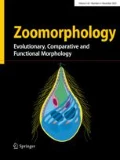Abstract
Male squid produce intricate spermatophores that, when transferred to the female, undergo the spermatophoric reaction, a complex process of evagination that leads to the attachment of the spermatangium, that is, the everted spermatophore containing the sperm mass. While this process is still not completely understood, the medical literature includes several reports of “oral stinging” (i.e., punctured wounds in the human oral cavity) following consumption of raw male squid, which contains undischarged spermatophores able to inflict such wounds. Here, we revisit a recent medical report of oral stinging by Shiraki et al. (Pathol Int 61:749–751, 2011), providing an in-depth reanalysis of their histological biopsies and revealing vital information on the functioning of squid spermatophores. The morphology of the spermatangia attached within the oral cavity is similar to the condition found in spermatangia naturally attached to female squids. The spermatangia were able to superficially puncture the superficial layers of the oral stratified squamous epithelium, and numerous, minute stellate particles from the squid spermatophore were found adhered to the oral epithelium. These findings corroborate previous hypotheses on the functioning of squid spermatophores, namely that spermatophore attachment generally involves tissue scarification, and that stellate particles play a vital role in the attachment process. Moreover, spermatophore attachment is confirmed to be autonomous (i.e., performed by the spermatophore itself) in another squid species (possibly a loliginid), and the results strongly indicate that the attachment mechanism is not dependent upon a specialized epithelium, nor a mate’s specific chemical stimulus. From the pathological point of view, the best prophylactic measure at present is the removal of the internal organs of the raw squid prior to its consumption.




Similar content being viewed by others
References
Arkhipkin AI, Laptikhovsky VV (2011) Observation of penis elongation in Onykia ingens: implications for spermatophore transfer in deep-water squid. J Molluscan Stud 76:299–300
Drew GA (1911) Sexual activities of the squid, Loligo pealii. I. Copulation, egg-laying and fertilization. J Morphol 22:327–359
Drew GA (1919) Sexual activities of the squid Loligo pealii (Les.). II. The spermatophore; its structure, ejaculation and formation. J Morphol 32:379–435
Hamada A, Watanabe N, Yamazaki Y, Yoshiba S, Kobayashi A (1990) A case of punctured wounds in the oral cavity by sperm-bags of squid. Med Entomol Zool 41:279–280 (in Japanese; abstract in English)
Hess SC (1987) Comparative morphology, variability, and systematic applications of cephalopod spermatophores (Teuthoidea and Vampyromorpha). University of Miami, Dissertation
Hoving HJT, Laptikhovsky V (2007) Getting under the skin: autonomous implantation of squid spermatophores. Biol Bull 212:177–179
Hoving HJT, Nauwelaerts S, Van Genne B, Stamhuis EJ, Zumholz K (2009) Spermatophore implantation in Rossia moelleri Steenstrup, 1856 (Sepiolidae; Cephalopoda). J Exp Mar Biol Ecol 372:75–81
Jereb P, Vecchione M, Roper CFE (2010) Family Loliginidae. In: Jereb P, Roper CFE (eds) Cephalopods of the world. An annotated and illustrated catalogue of species known to date, vol 2: Myopsid and Oegopsid Squids. FAO Species Catalogue for Fishery Purposes, No. 4. FAO, Rome, pp 38–117
Kawada K, Kawahara M, Akimori T, Yamaguchi T, Okamoto Y, Ishikawa Y (2008) A case of oral stings by spermatophores of Todarodes pacificus. Jpn J Oral Surg 54:423–426 (in Japanese; abstract in English)
Kawamoto F, Iwata T, Ichihara A, Kumada N, Kano R (1990) A case-report of oral-stings by spermatophores of a squid, Tadorodes pacificus Steenstrup. Jpn J Sanit Zool 41:117–119 (in Japanese; abstract in English)
Marian JEAR (2011) Perforating potential of loliginid spermatophores. J Molluscan Stud 77:98–100
Marian JEAR (2012a) Spermatophoric reaction reappraised: novel insights into the functioning of the loliginid spermatophore based on Doryteuthis plei (Mollusca: Cephalopoda). J Morphol 273:248–278
Marian JEAR (2012b) A model to explain spermatophore implantation in cephalopods (Mollusca: Cephalopoda) and a discussion on its evolutionary origins and significance. Biol J Linn Soc 105:711–726
Marian JEAR, Domaneschi O (2011) Unraveling the structure of squids’ spermatophores: a combined approach based on Doryteuthis plei (Blainville, 1823) (Cephalopoda: Loliginidae). Acta Zool. doi:10.1111/j.1463-6395.2011.00503.x
Nagakura K, Nakano M, Kanamaru M (1992) Two cases of oral-stings by sperm bag of squid. Tokai J Exp Clin Med 17:195–197
Nakashima H, Akagi M, Miyabe S, Iwasawa H (1996) Two unusual cases of a foreign body in the oral cavity caused by eating raw squid. Acta Otolaryngol Suppl 522:104–107
Nesis KN (1995) Mating, spawning and death in oceanic cephalopods: a review. Ruthenica 6:23–64
Park G-M, Kim J-Y, Kim J-H, Huh J-K (2011) Penetration of the oral mucosa by parasite-like sperm bags of squid: a case report in a Korean woman. J Parasitol 98:222–223
Roper CFE, Nigmatullin C, Jereb P (2010) Family Ommastrephidae. In: Jereb P, Roper CFE (eds) Cephalopods of the world. An annotated and illustrated catalogue of species known to date, vol 2: Myopsid and Oegopsid Squids. FAO Species Catalogue for Fishery Purposes, No. 4. FAO, Rome, pp 269–347
Shiraki Y, Kawai K, Kojima S, Suzuki Y, Ono K (2011) Stinging in the oral cavity caused by ingestion of the sperm bags of a squid: a case report. Pathol Int 61:749–751
Takahama H, Kinoshita T, Sato M, Sasaki F (1991) Fine structure of the spermatophores and their ejaculated forms, sperm reservoirs, of the Japanese common squid, Todarodes pacificus. J Morphol 207:241–251
Takai K, Nakajima H, Hanaguri M, Kanda T (1989) A case of stinging in the upper gastrointestinal tract by eating raw squids. Jpn J Sanit Zool 40:227 (in Japanese)
Acknowledgments
JEARM was supported by a postdoctoral fellowship from CAPES (Coordenação de Aperfeiçoamento de Pessoal de Nível Superior). The comments of two anonymous reviewers improved the manuscript and are greatly appreciated.
Author information
Authors and Affiliations
Corresponding author
Additional information
Communicated by A. Schmidt-Rhaesa.
Rights and permissions
About this article
Cite this article
Marian, J.E.A.R., Shiraki, Y., Kawai, K. et al. Revisiting a medical case of “stinging” in the human oral cavity caused by ingestion of raw squid (Cephalopoda: Teuthida): new data on the functioning of squid’s spermatophores. Zoomorphology 131, 293–301 (2012). https://doi.org/10.1007/s00435-012-0165-0
Received:
Revised:
Accepted:
Published:
Issue Date:
DOI: https://doi.org/10.1007/s00435-012-0165-0




